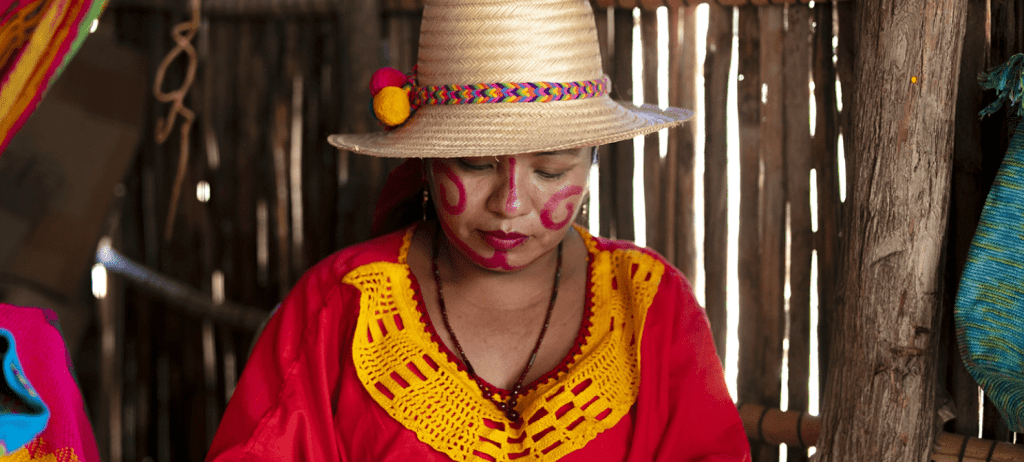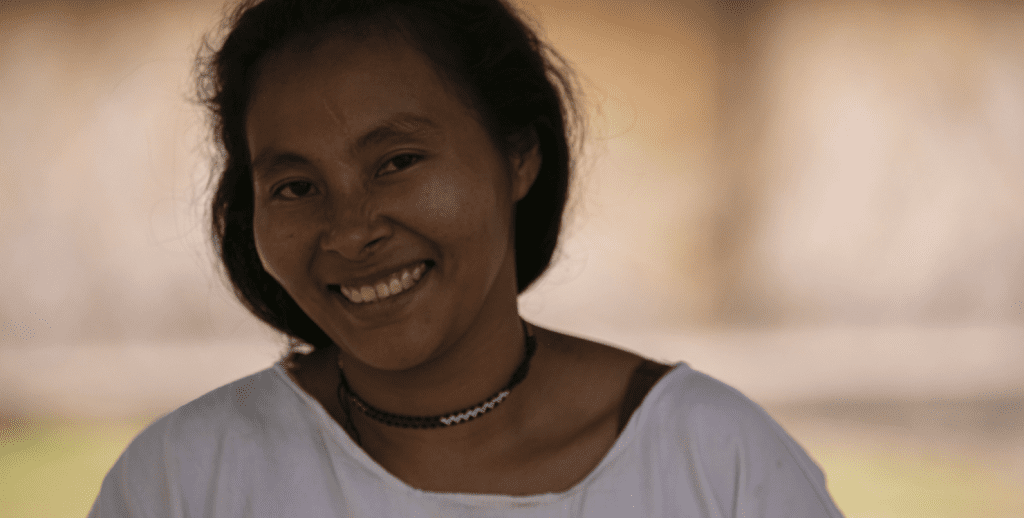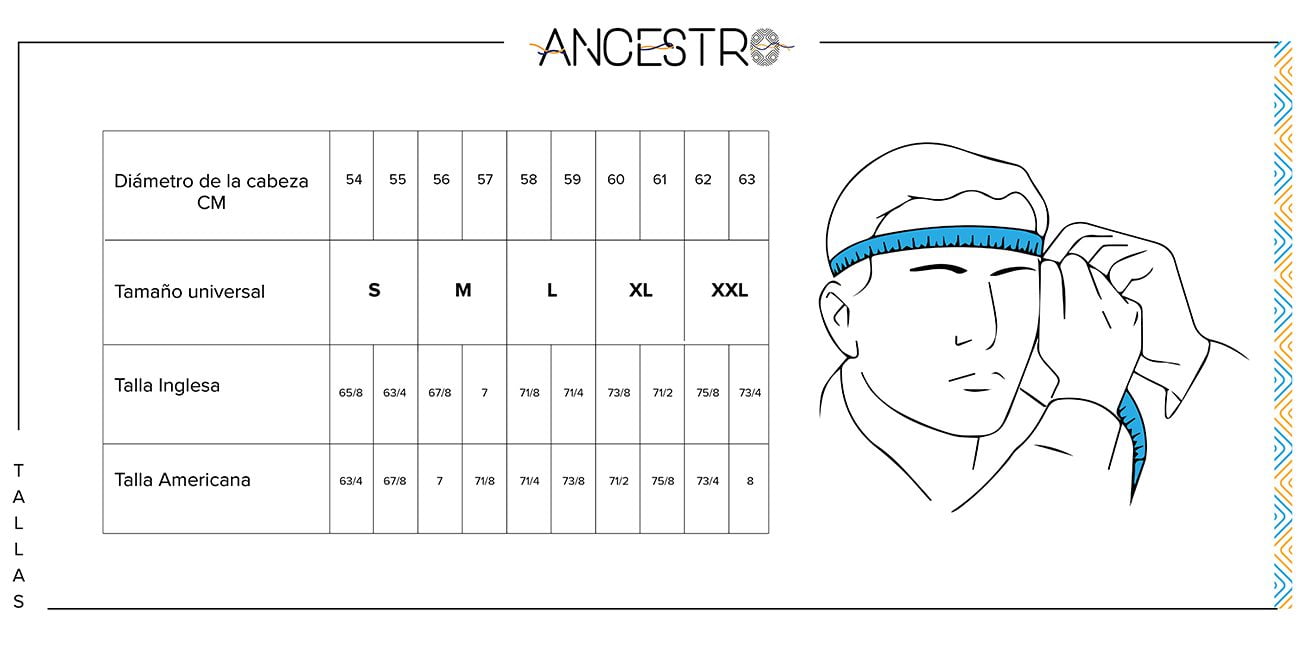Cultures
At ANCESTRO (HATS), we seek to create innovative and unique artisan-designed products with indigenous communities. The driving force behind this initiative is the designs and pictographic language of the textiles made by the WAYÚU, INGA, KAMSÁ, MISAK, and ARHUACO cultures of Colombia. To this end, we are exploring the idea of a brand linked to a project that integrates new trends in artisanal design with the indigenous weaving community.
Wayúu
Wayúu
 The Guajira Peninsula is one of the most beautiful places in Colombia. Its beaches, the color of the sea contrasting with the yellow sand, a nature reserve or an oasis in the middle of the desert, and of course the Wayúu indigenous people, are all part of this splendid place, full of spaces that will satisfy your eyes with their beauty.
Mistreated in their culture and with many needs, such as drinking water, La Guajira is one of the magical places worth visiting in Colombia, on a trip without many pretensions, to sleep in a hammock (if you want) under the stars, while the Caribbean breeze lulls you to sleep, enjoying a natural paradise that is hard to find anywhere else in the world.
The Guajira Peninsula is one of the most beautiful places in Colombia. Its beaches, the color of the sea contrasting with the yellow sand, a nature reserve or an oasis in the middle of the desert, and of course the Wayúu indigenous people, are all part of this splendid place, full of spaces that will satisfy your eyes with their beauty.
Mistreated in their culture and with many needs, such as drinking water, La Guajira is one of the magical places worth visiting in Colombia, on a trip without many pretensions, to sleep in a hammock (if you want) under the stars, while the Caribbean breeze lulls you to sleep, enjoying a natural paradise that is hard to find anywhere else in the world.
La Guajira – Colombia
 Its inhabitants, mostly indigenous Wayúu, are part of the beautiful landscape throughout the peninsula. Their most important tradition is weaving, with which women weave backpacks, hammocks, and hammocks that are sold in many places around the world, where their reality is unknown. It is a beautiful community with a lot of mythological content, with much to offer.
Its inhabitants, mostly indigenous Wayúu, are part of the beautiful landscape throughout the peninsula. Their most important tradition is weaving, with which women weave backpacks, hammocks, and hammocks that are sold in many places around the world, where their reality is unknown. It is a beautiful community with a lot of mythological content, with much to offer.
Arhuacos
Arhuacos
 Literally tucked away in the mountainous areas of northern Colombia live the Arhuacos indigenous people, who share their territory with the Koguis and the Wiwas. They are deeply spiritual and believe that their natural and social environments should be one and the same, developing naturally.
The different mountain heights allow them to grow different types of products for their own consumption and for sale in the lower parts of the mountains.
Literally tucked away in the mountainous areas of northern Colombia live the Arhuacos indigenous people, who share their territory with the Koguis and the Wiwas. They are deeply spiritual and believe that their natural and social environments should be one and the same, developing naturally.
The different mountain heights allow them to grow different types of products for their own consumption and for sale in the lower parts of the mountains.
Sierra Nevada – Colombia
 One of their ancestral customs is hand weaving with sheep’s wool, capturing their natural environment and its integration with themselves, starting with meanings intertwined with the matrix of the Arhuaco woman. A culture with much to discover and much to offer.
One of their ancestral customs is hand weaving with sheep’s wool, capturing their natural environment and its integration with themselves, starting with meanings intertwined with the matrix of the Arhuaco woman. A culture with much to discover and much to offer.
Inbga & Kamsá
Inga & Kamsá
 Suddenly you find yourself in the Sibundoy Valley in Putumayo, Colombia. It is a special place because of its natural surroundings, its inhabitants, and the lungs that close and expand in its beautiful mountains. It is a place where dogs (all chubby) are part of the town and the jaguar watches over the mountain from its home.
The home of the Inga and Kamsá communities. They mixed when the Incas arrived and conquered the land of the Kamentzá. The Incas being a more developed people, the stage was set to conquer the Kamentzá people who had inhabited the Sibundoy Valley region for decades. In the midst of this Inca conquest, the Spanish arrived, conquering both peoples and establishing themselves religiously, culturally, and politically in the indigenous territory.
Today, the Sibundoy Valley is made up of four towns, Santiago, Colón, San Francisco, and Sibundoy, all four of which are inhabited by indigenous people from the two cultures, the Inca and Kamsá, whose ancestral tradition is weaving with thread and beads. Bead weaving is a tradition brought from ancient celebrations, where they made necklaces woven with small gold nuggets to be worn by some of them.
Sibundoy Valley
Putumayo
Suddenly you find yourself in the Sibundoy Valley in Putumayo, Colombia. It is a special place because of its natural surroundings, its inhabitants, and the lungs that close and expand in its beautiful mountains. It is a place where dogs (all chubby) are part of the town and the jaguar watches over the mountain from its home.
The home of the Inga and Kamsá communities. They mixed when the Incas arrived and conquered the land of the Kamentzá. The Incas being a more developed people, the stage was set to conquer the Kamentzá people who had inhabited the Sibundoy Valley region for decades. In the midst of this Inca conquest, the Spanish arrived, conquering both peoples and establishing themselves religiously, culturally, and politically in the indigenous territory.
Today, the Sibundoy Valley is made up of four towns, Santiago, Colón, San Francisco, and Sibundoy, all four of which are inhabited by indigenous people from the two cultures, the Inca and Kamsá, whose ancestral tradition is weaving with thread and beads. Bead weaving is a tradition brought from ancient celebrations, where they made necklaces woven with small gold nuggets to be worn by some of them.
Sibundoy Valley
Putumayo
Misak
Misak
 Misak, better known as “water people.”
The Misak or Guambiano people, as they have also been called, are concentrated in the central mountain range in the department of Cauca, where they share territory with the Nasas or Paeces.
They live mainly in the municipality of Silvia, coexisting in reserves around the urban centers of these municipalities. Within the reserve, each family has a plot of land on which to build.
The Guambía reserve is one of the most populated and one of the most traditional. There, they practice their own customs and use the Nam trik language (which, according to their elders, means “the voice that emerges from the waters, from the source, to prolong life and coexist with the mother; the word is not imposed, but rather one of respect and listening”). They are knowledgeable about botany and medicinal plants, expert weavers, and farmers.
Municipality of Silvia
Cauca – Colombia
Misak, better known as “water people.”
The Misak or Guambiano people, as they have also been called, are concentrated in the central mountain range in the department of Cauca, where they share territory with the Nasas or Paeces.
They live mainly in the municipality of Silvia, coexisting in reserves around the urban centers of these municipalities. Within the reserve, each family has a plot of land on which to build.
The Guambía reserve is one of the most populated and one of the most traditional. There, they practice their own customs and use the Nam trik language (which, according to their elders, means “the voice that emerges from the waters, from the source, to prolong life and coexist with the mother; the word is not imposed, but rather one of respect and listening”). They are knowledgeable about botany and medicinal plants, expert weavers, and farmers.
Municipality of Silvia
Cauca – Colombia
 The Misak preserve traditional practices in the production of different fabrics. Each family has a loom that is usually used by the women.
The Misak preserve traditional practices in the production of different fabrics. Each family has a loom that is usually used by the women. Personaliza tu Sombrero
Personalizar tu sombrero es muy sencillo, contáctanos y déjanos saber como te lo imaginas, para hacerlo realidad.

